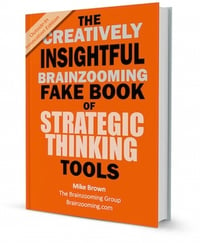Devising and implementing an innovation strategy seems as if it SHOULD be easier in certain business environments. For instance, companies depending on innovative products and services as a main driver of customer brand value might give innovation strategy a higher priority. One might also suspect the change management related to innovation strategy would be easier at a place such as Disney; heck, Disney has Imagineers!
A recent Fast Company article suggests, however, that the innovation strategy and change management struggles for the new guest experience at Disney are similar to those at less glitzy brands. Our friends at Armada Executive Intelligence recapped the Fast Company article in their "Inside the Executive Suite” weekly feature, highlighting four change management struggles with a major guest experience innovation strategy at Disney. Here's the "Inside the Executive Suite" recap:
Innovation Strategy - 4 Change Management Struggles at Disney
The new Fast Company (May 2015) covers the challenge of devising, developing, and implementing a transformational customer experience for a brand. As is typical, upending long-standing processes entrenched employees have created and used to build successful careers stirs up significant resistance.
There's something atypical about the situation described in, "The Messy Business of Reinventing Happiness," though. The story plays out inside a major division of a corporation whose R&D staff members are known by the seemingly change-embracing title of "Imagineers!"
Yes, even Disney faces innovation-related change management issues.
Realities of Dramatic Change
We recommend reading business magazine case studies with skepticism. The article on the $1 billion Disney investment in MyMagic+, which PROMISES to remake the guest experience at Disney parks, however, rings true. It addresses innovation and change management twists and turns comparable articles often neglect.
We're highlighting quotes from Fast Company that represent issues most brands face during periods of significant change. Each reinforces important innovation and change management principles.
1. Don't Look Only Inside and Expect Breakthrough Thinking
Quote: “Flipping through a SkyMall catalog, he (John Padgett, VP of business development) landed on a page featuring the Trion:Z, a magnetic wristband that promised to reduce muscle soreness while simultaneously improving one’s golf swing. The team started to consider whether Disney could create an electronic band that could digitally carry everything a guest might need.”
Situation: Metrics on guest expectations for returning to Disney World were declining. The culprits were high ticket prices, protracted wait times, and a variety of other inconveniences. While guests were identifying significant issues, they couldn’t describe the fixes. Additionally, management team members wedded to the reality of current systems often aren’t able to see breakthrough remedies either.
The MagicBand bracelet, the central piece of the Disney Next Generation Experience (NGE) project, addresses multiple functions, including serving as a digital ticket, money, ride photo organizer, and coupon holder. It also shares information helping dynamically manage the guest experience.
Principle: Your business breakthrough could be what’s new (or even traditional) in another industry. Innovators must continually scan outside inspirations from unlikely places and industries.
2. Knowing "What Matters" Is Vital to Innovation
Quote: "This kind of traffic management wouldn't just be a service to customers - it could also help Disney fit more guests inside its parks."
Situation: From an initial visit to the Disney World parks decades ago, one thing was apparent. Nearly everything in the Disney customer experience strategy links to how it keeps guests in the parks for more hours each day for as many days as possible.
Pricing (relatively expensive soft drinks, inexpensive rain slickers plus multi-day pricing packages tied to the number of hotel stay days), access policies (on-property guests receiving preferential early park access), managing time expectations (starting ride experiences many minutes before actually reaching the actual ride), and service niceties (transporting purchases to your hotel room) all made sense for keeping you IN THE PARK longer.
Principle: Even amid dramatic innovation, certain aspects of an organization’s underlying business model may remain sound. Successful innovation strategies benefit from starting with a clear understanding of what needs changing and what needs reinforcement.
3. Not Every Group Thinks the Same Things Matter
Quote: “’You had operations pushback, security and fraud pushback, creative pushback.’ They faced opposition from a powerful corporate force: Disney’s Imagineers…Imagineers argued that the uniformity of the access points (where MagicBands were to be scanned) would disrupt the spirit of their uniquely stylized attractions.”
Situation: Despite the importance of maximizing guest time in the parks, other views of "what matters" exist within Disney. For Imagineers, what matters is immersing park guests in another world of delight that brings them back multiple times. When seamless immersion is “what matters,” even innovative ideas that might disrupt a guest’s experience or could grow stale quickly deteriorate what they are trying to create. Trendy change isn’t good; it’s seen, in fact, as dangerous.
Principle: While a company with a strong strategy creates understanding of its strategy throughout the company, “what matters” DOES differ as multiple levels and parts of the organization implement it. The internal tension in determining the best combination of initiatives to bring the overall strategy to life is why strategy setting isn’t a one-time endeavor. Strategy is lived out daily and employees need support in interpreting and shaping it.
4. Bring Innovation to Life As Soon as Possible
Quote: “The NGE team built out its advanced R&D lab, or what (Executive VP, Nick) Franklin calls a ‘living blueprint’ that would ‘sell the vision.’ With typical Disney flair, the soundstage became a storyboard brought to life, with a full-scale living room…where the archetypal family would book their Disney vacation…(plus) a flight-arrival stage of the set…the hotel set…(and) mock-ups of the in-park experience.”
Situation: It’s one thing to discuss an innovative concept matter-of-factly. It’s another to share compelling stories about it. It’s off the charts to create an immersive prototype to help strategists, executives, and team members experience and react to the concept. As Disney-knowledgeable sources put it, the “’theater’ of selling an idea is more important than the idea itself.’”
Principle: Most organizations don’t have a movie set to prototype a new concept with an immersive experience. Every organization does, however, have prototyping resources. If the innovation is a new product concept, go to the manufacturing floor to demo it. If you are imagining ways to interact with a B2B customer, mock up the customer’s environment in a meeting room. We saw a trucking company do this to re-create a traffic manager’s office. Suddenly innovation opportunities were readily apparent. - Armada Executive Intelligence
If you enjoyed this article, subscribe to the free Brainzooming blog email updates.
Looking for Ways to Develop a Successful
Innovation Strategy to Grow Your Business?
Brainzooming Has an Answer!
 Business growth can depend on introducing new products and services that resonate more strongly with customers and deliver outstanding value.
Business growth can depend on introducing new products and services that resonate more strongly with customers and deliver outstanding value.
Are you prepared to take better advantage of your brand’s customer and market insights to generate innovative product ideas? The right combination of outside perspectives and productive strategic thinking exercises enables your brand to ideate, prioritize, and propel innovative growth.
Download this free, concise ebook to:
- Identify your organization’s innovation profile
- Rapidly deploy effective strategic thinking exercises to spur innovation
- Incorporate market-based perspectives into your innovation strategy in successful ways
Download this FREE ebook to turn ideas into actionable innovation strategies to drive your organization’s comeback!
[sc:Outside-In ]




